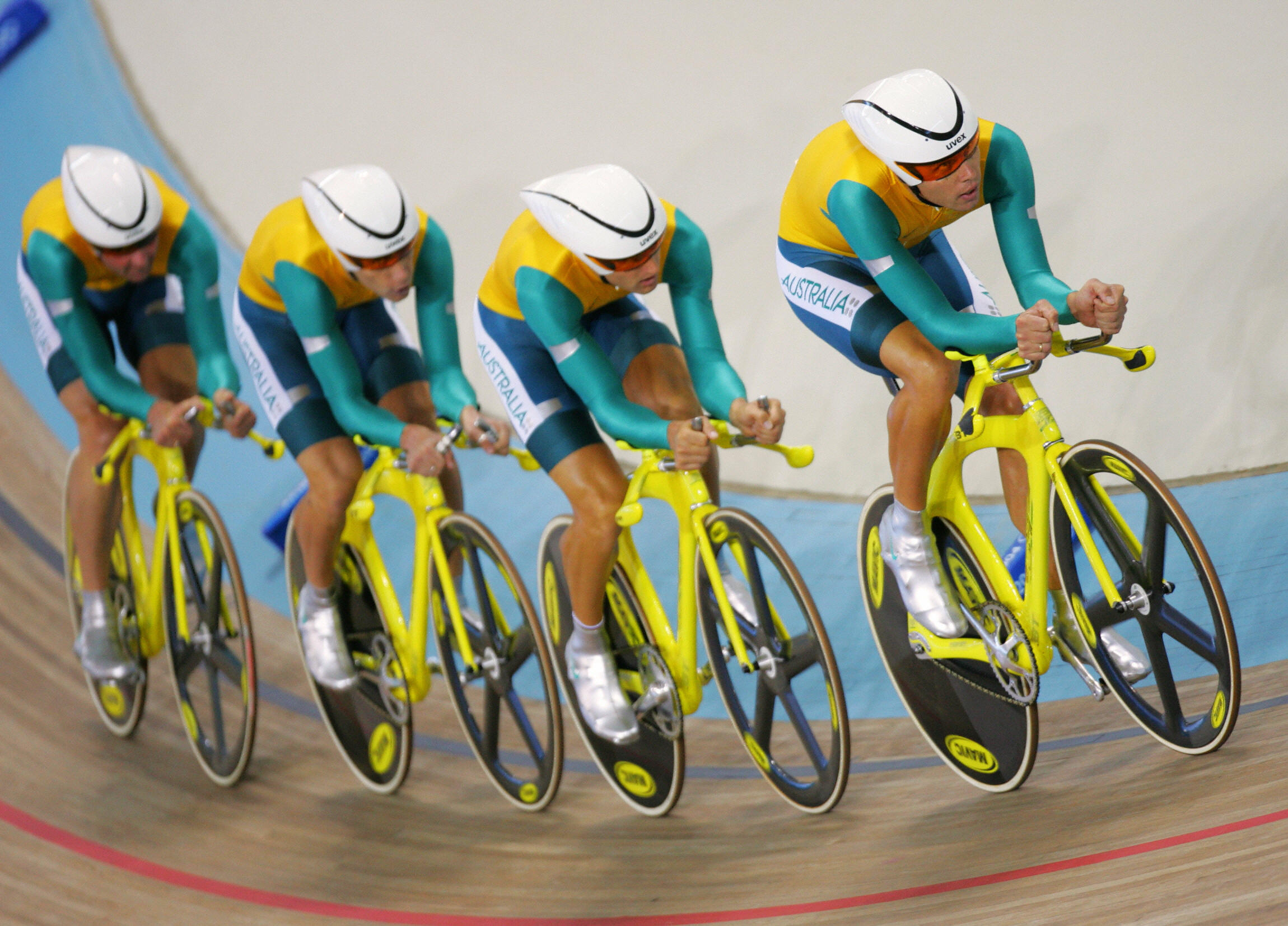
Australia won Olympic Gold on Wednesday night in the Men's Team Pursuit final after a closely fought race against Great Britain. Sam Welsford, Oliver Bleddyn, Conor Leahy and Kelland O’Brien rode to a time of 3:42.067 in the final, a couple of seconds off their own World Record time of 3:40.730, set in an earlier round.
Gold in Paris is surely the result of years of tireless hard work in the Team Pursuit event for the Australian men. It was their first Olympic Team Pursuit title since 2004, and Games in Beijing, London, Rio and Tokyo have passed since that victory on the boards of the Athens Velodrome.
They have lost to their great rivals Great Britain on a few occasions in the 20 years since then, suffered mechanical disaster or have been slightly off the pace as other rival nations came to the fore. But on the Paris track, the team fought to victory and took the Olympic Team Pursuit title home to Australia again for another four years.
Since 2004, the Team Pursuit event has changed almost beyond recognition, in terms of speed, equipment and the way teams ride races.
We've taken a look back at the Australian Team Pursuit squads' bikes, kit, tech and event times from Athens to the present day in Paris on their journey to reclaiming the title.
In the 20 years since 2004, big advances have been made in track technology, particularly regarding aerodynamics, for all nations, not just Australia. In two decades they have taken 16 seconds off the Team Pursuit world record. Advancing it from 3:56.610 in Athens to the mark of 3:40.730 that they rode in Paris. Two World Records and two Olympic Gold medals aren't a bad way to bookend 20 years of work.
Work your way through this piece and notice the change in pursuit positions as riders have transitioned from flat, even downward-pointing arms that were popular at the time to the 'praying mantis' style position that is now common on the road and track, with the arms coming up and in to close off the gaping space left by having horizontal arms on tri bars.
Bikes have also changed, getting narrower and then super wide as is the trend and current way of thinking for several nations. The Australian team has used three different bike brands over the past 20 years and three different brands of wheels, that we know about.
We've tried to point out notable or interesting kit choices along the way as the team's equipment package has changed and developed. We weren't there in person for these events, so if you spot something we've missed or want to tell us about, send us a message.
Athens 2004
- 1st: 3.58.233
- *World Record set in heat 4 - 3:56.610
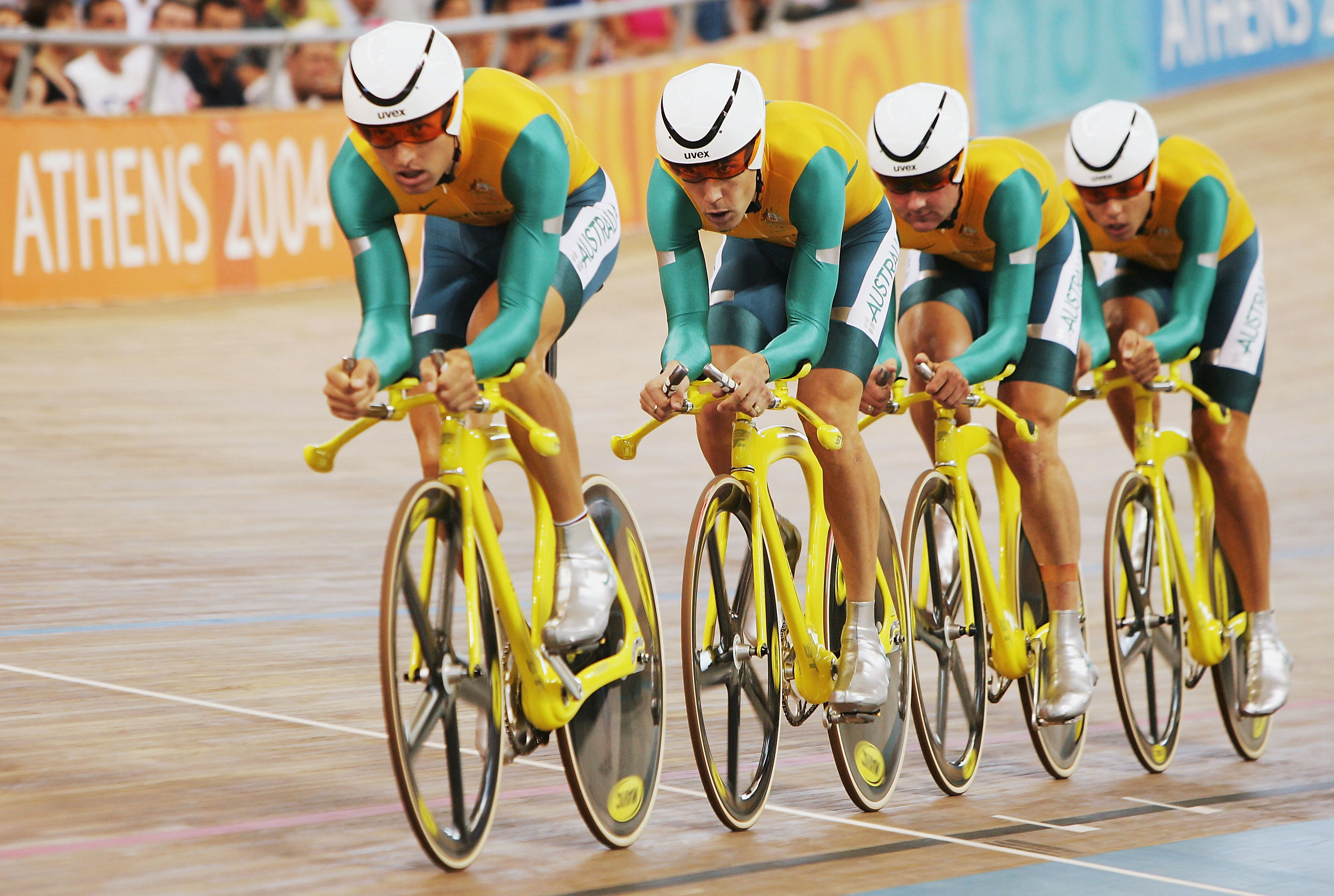
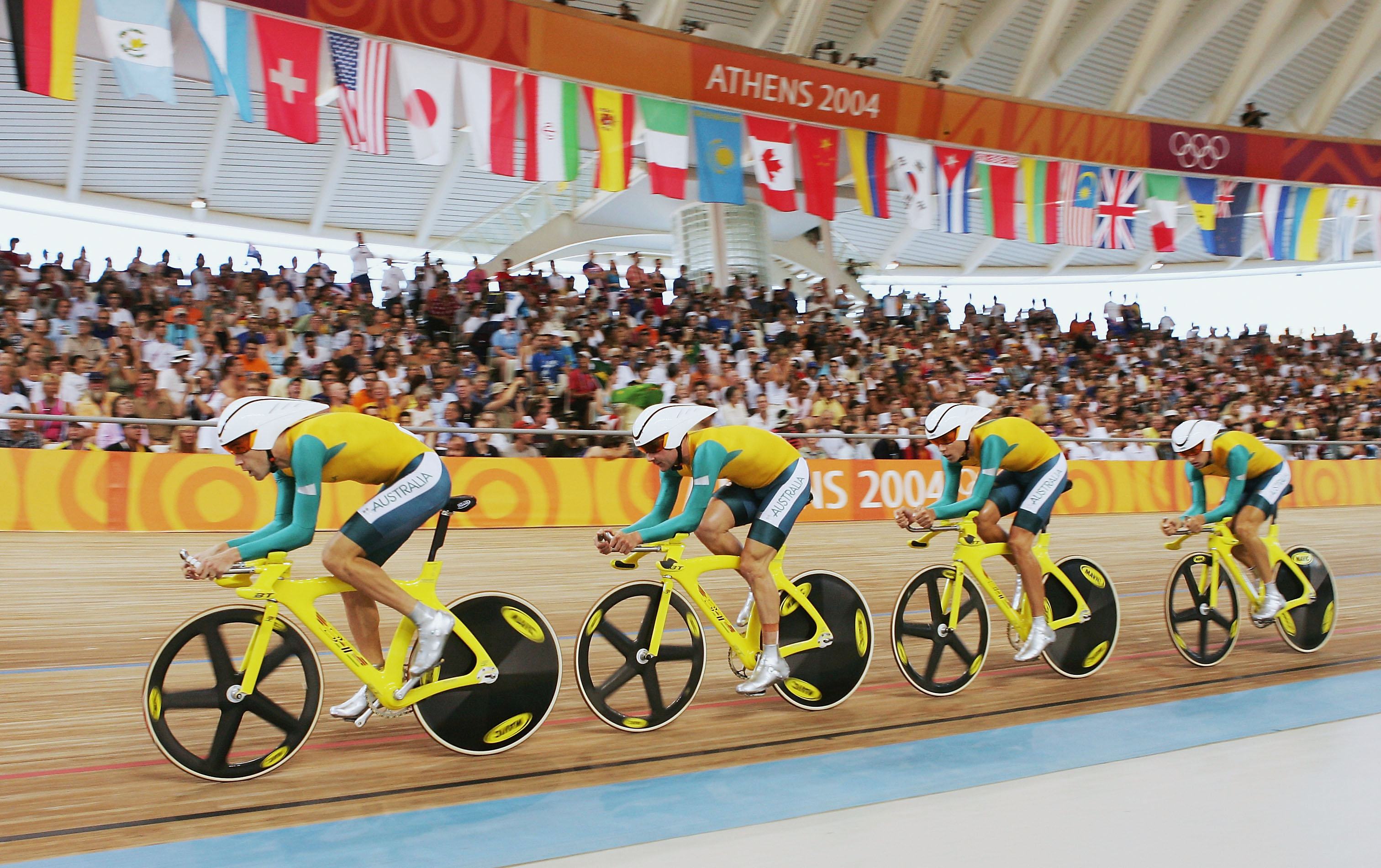

Australia emerged victorious in Athens, the team of Brad McGee, Brett Lancaster, Graeme Brown and Luke Roberts rode to a winning time of 3.58.233, beating the Great Britain squad of Steve Cummings, Rob Hayles, Paul Manning and Bradley Wiggins who rode a 4.01.760.
Like Paris, the Australians set a new world record in heat 4 of the competition with a 3:56.610. At the time, a sub four-minute 4k Team Pursuit was a big deal, but this 3:56.610 time is only our starting point when looking at the progression of times over the next 20 years.
Australian track teams used Australian BT (Bike Technologies) track frames for years and that was the case in Athens. The team rode carbon fibre BT frames and handlebars with the legendary Mavic Comete disc wheel and IO five-spoke front wheel. Surely the most successful wheelset in track cycling history (so far).
Like now, Vittoria Tubular tyres were very popular on the track and the team rode a Vittoria Evo CS variant. At least two of the chainsets look to be Campagnolo Record Pista track chainsets. This is one area that has seen clear development, for years Dura Ace, Sugino or Campagnolo chainsets were mainly used on the track, but they have given way these days to custom aero chainsets often with carbon fibre crank arms.
Long-tail aero helmets were from Uvex while the overshoes were the popular-at-the-time Nike Swift model (spot the small Nike ticks) which were commercially available too. The skinsuits also have a Nike tick, but we don't know if this was just a rebrand of another model for the Olympics.
Beijing 2008
- 4th: 3:59.006
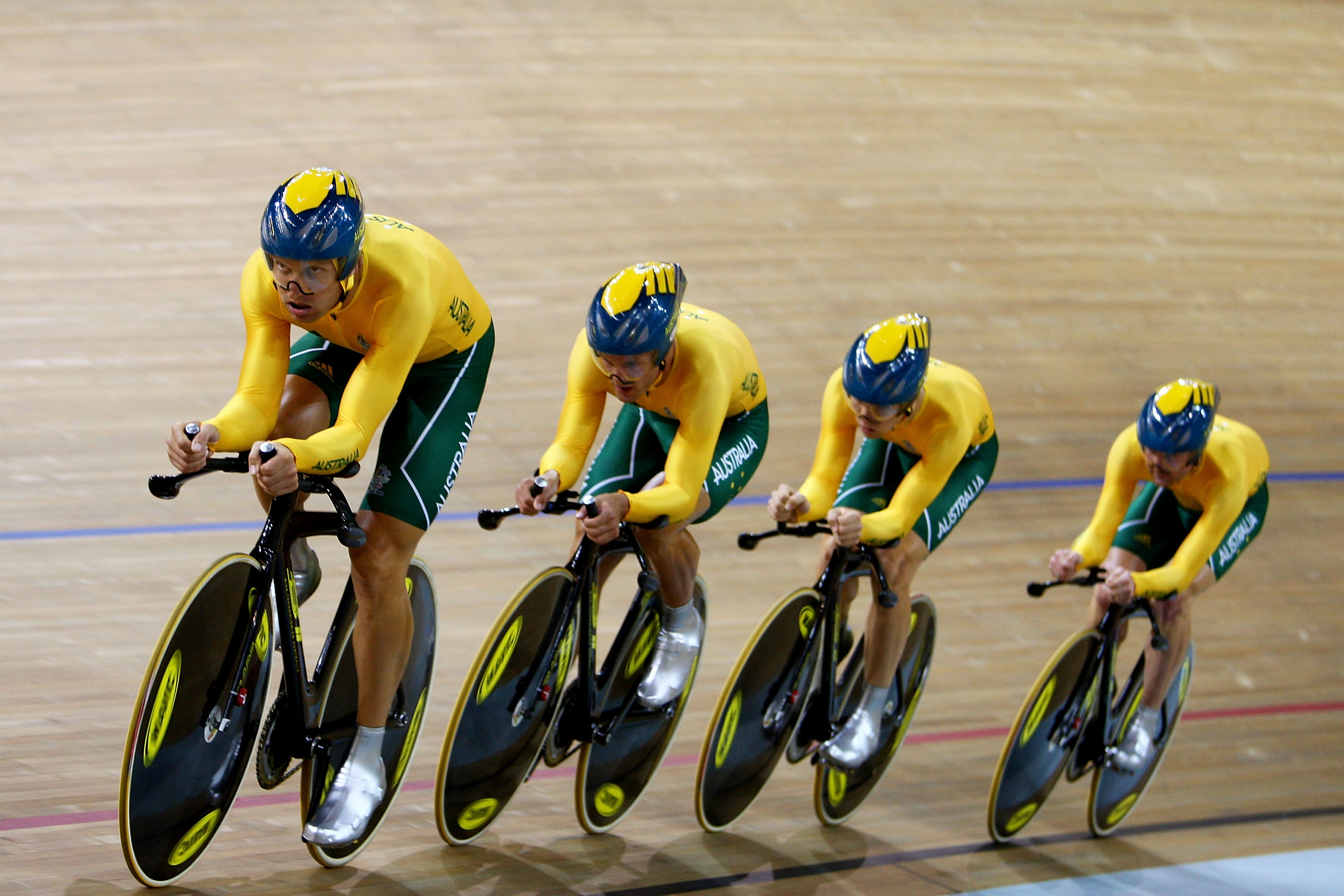


The Australians didn't repeat their Athens success in Beijing, and instead it was Great Britain who took gold. The team of Jack Bobridge, Graeme Brown, Mark Jamieson and Bradley McGee rode to a fourth-place finish and only just managed to dip inside the four-minute mark with a 3:59.006, slower than their time four years previous in Athens.
The BT frames had changed from yellow to largely black, and the Mavic IO five spokes had been swapped for front Comete disc wheels on the indoor Laoshan track. The time trial bars were still BT models and again featured skateboard grip tape. The Vittoria tubular tyres were also still there. Arms positions were still pretty much horizontal in 2008 and the move towards bringing the arms upward hadn't started yet.
One area that had changed was the team's chainsets. The Campagnolo chainsets were gone and replaced with all-black chainsets with more aerodynamic chainrings.
Helmets had clear visors and were from Bell, which had had their vents covered up. The team appeared to have been using overshoes that were very similar to the Nike Swift model in appearance. Skinsuits had Adidas branding, but like Athens, we don't know if this was a rebrand.
After a disappointing finish, the hunt to get back into the medals must have been on heading for the London 2012 Games.
London 2012
- 2nd: 3:54.581
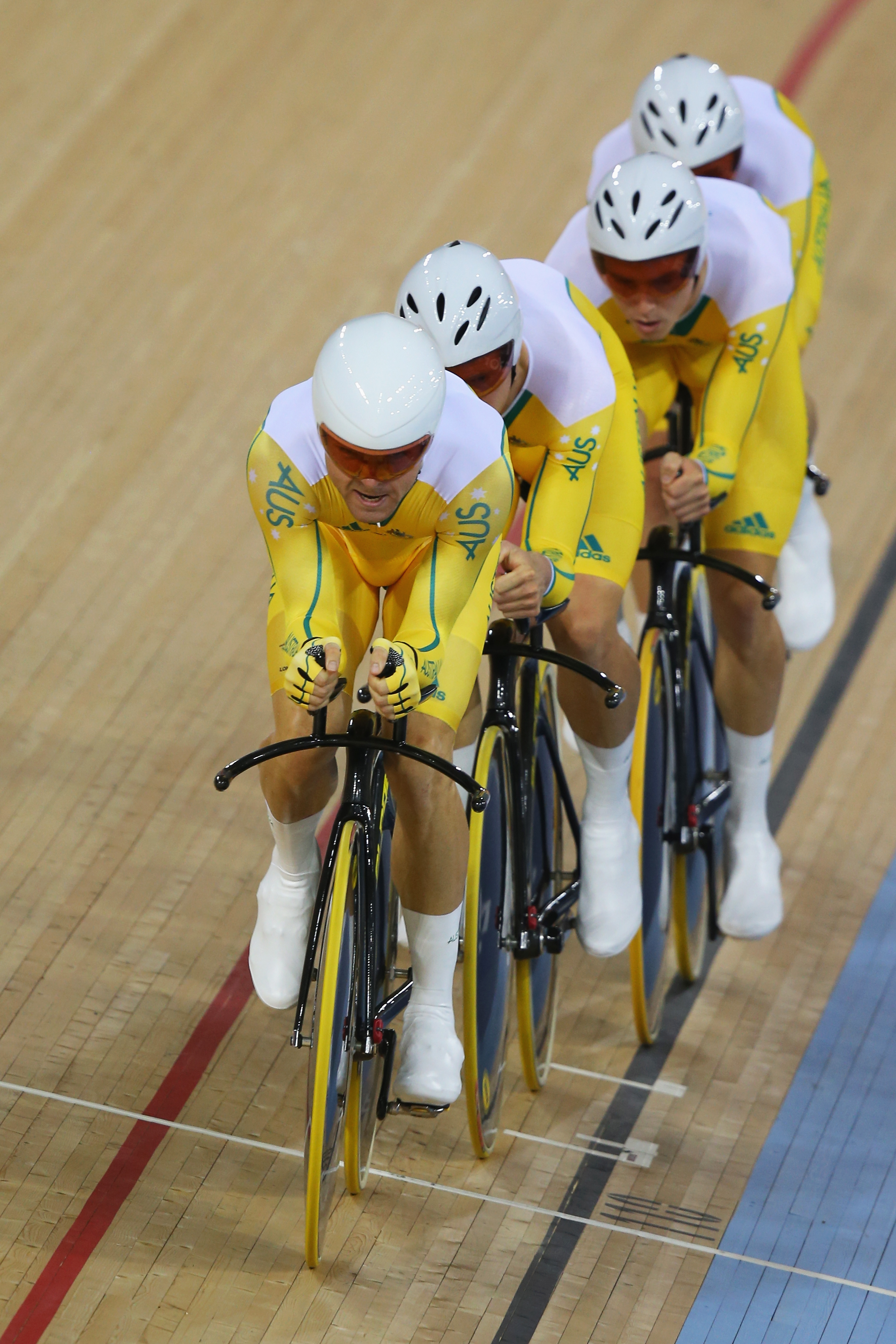
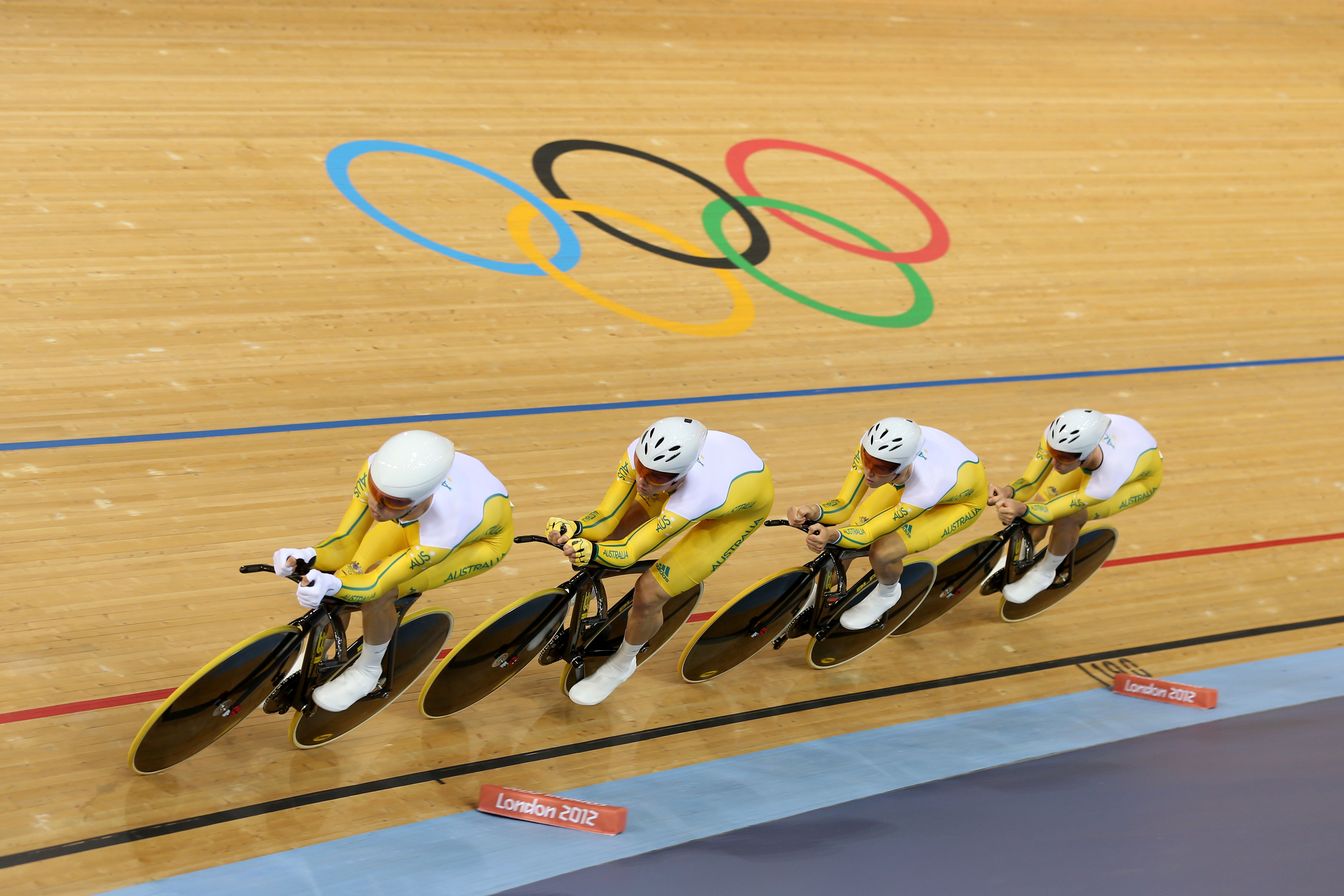

Australia were back in the medals for London 2012. The team had some new members and Jack Bobridge, Glenn O'Shea, Rohan Dennis, and Michael Hepburn raced to a 3:54.581.
Position-wise, arms were still mostly horizontal in London but there's a slightly positive hand and arm angle creeping in compared to Beijing, a sign of what was coming. There also looked to be some spacers used under the handlebar pads, another thing that's often seen to help riders tuck into an aero position now.
The BT frames and handlebars at least look similar, although the base bar had received some tweaks. The black aero chainsets and Mavic Comete discs remained as did the Vittoria tubular tyres. The team had new aerodynamic rubbery-looking white overshoes for the games that extended further up the ankle than the previous silver ones. A sign of things moving toward the norm these days with fairly high aero socks and overshoes.
Interestingly, the team used vented helmets except for Jack Bobridge who had a completely smooth model. We wonder if this was in case he started in the first position and was taking wind first on the front. Skinsuits were again branded Adidas, but like in previous years, we don't know if this was a rebrand.
Rio 2016
- 2nd: 3:51.008
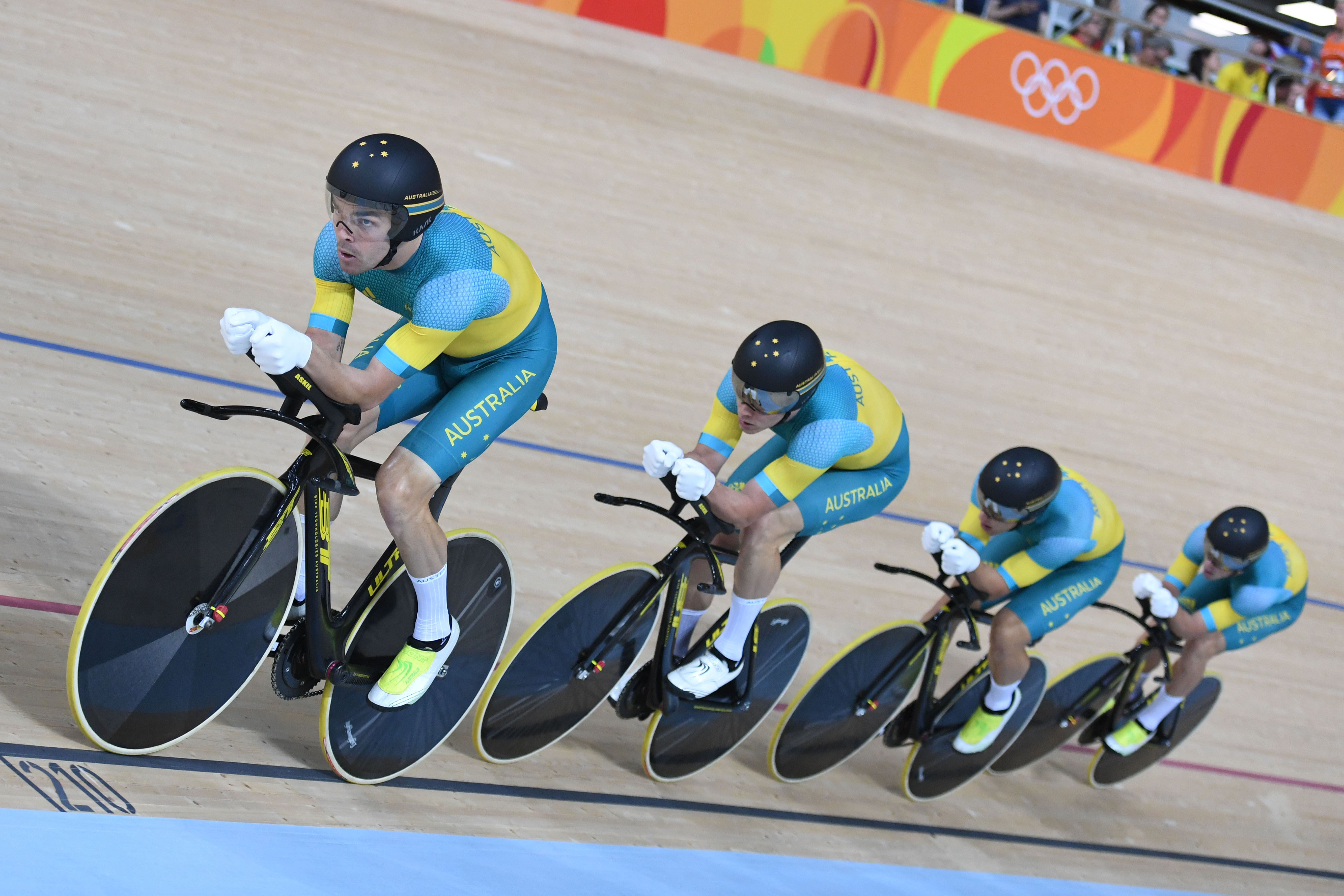
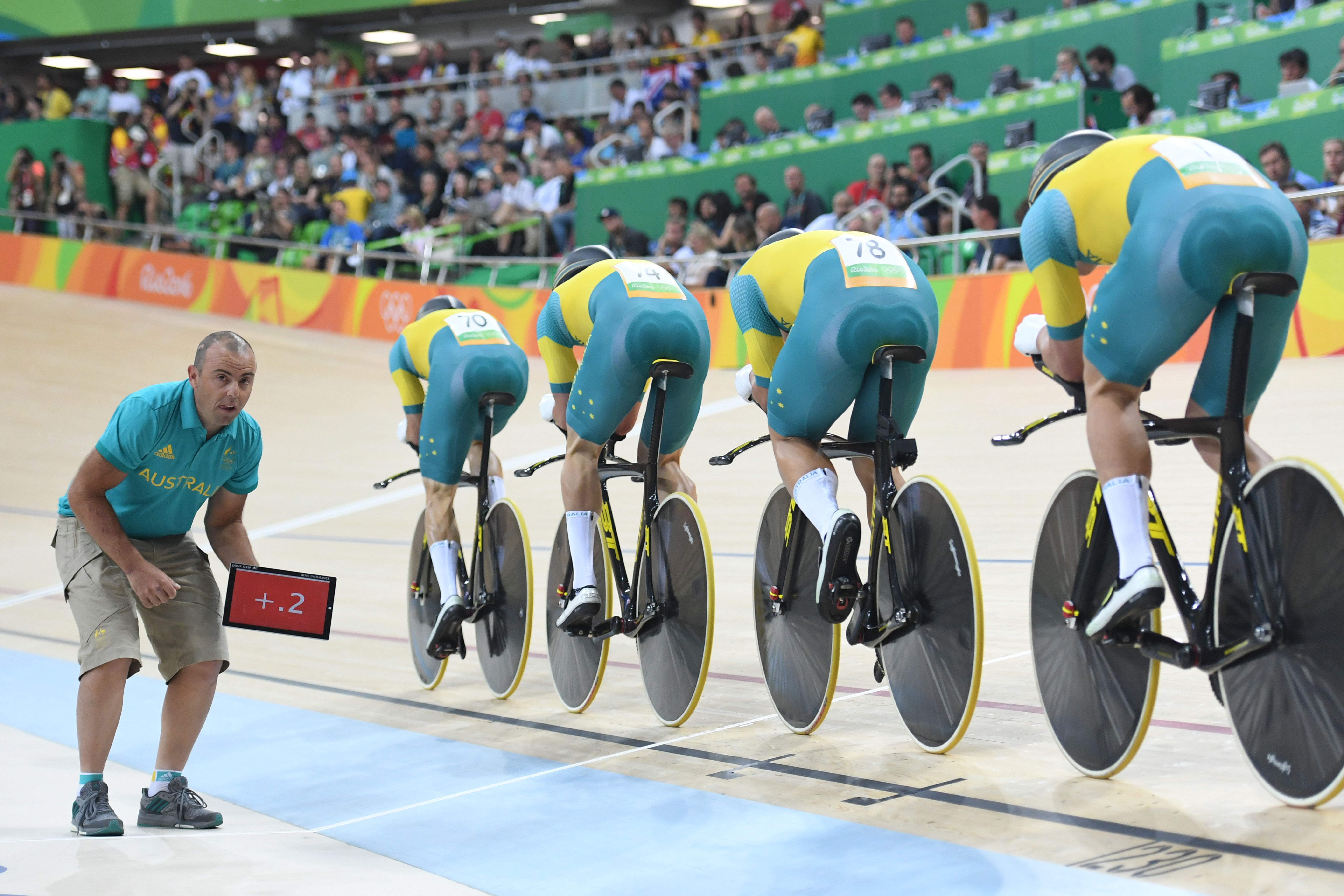

In Rio, the team of Alexander Edmondson, Jack Bobridge, Michael Hepburn and Sam Welsford went a few seconds faster than London 2012 and claimed another silver medal. Losing out to rivals Great Britain again as they rode to a World and Olympic record of 3:50.265. Teams may have done it behind closed doors, but the sub-3:50 barrier at the Olympics was close to being broken.
There appeared to be some interesting changes for the team in 2016 and it would be their last Olympics riding BT bikes after a long time together. Arm positions are changing here with the rider's arms clearly angled upwards, though not to the extent they are nowadays. Arm pad spacers again have a lot more material underneath them to raise them up.
Custom Bont shoes were used, renowned for their stiffness, as well as aero socks that zipped up at the rear - check out the zips in the rearward-facing picture. The riders also wore full-length, rubbery-looking gloves, perhaps these tested faster for them. Shorter, rounder, Kask aero helmets had also replaced the more teardrop-shaped vented helmets used in London.
Mavic Comete wheels had also been swapped for Lightweight carbon fibre disc wheels, also famed for their lightweight construction like the brand's regular road wheels. Rio 2016 almost feels like a transitional year between the older London and Beijing setups and what was to come in Tokyo and then Paris.
Tokyo 2021
- 3rd - Caught NZ in Bronze race
- Fastest time: 3:44.902

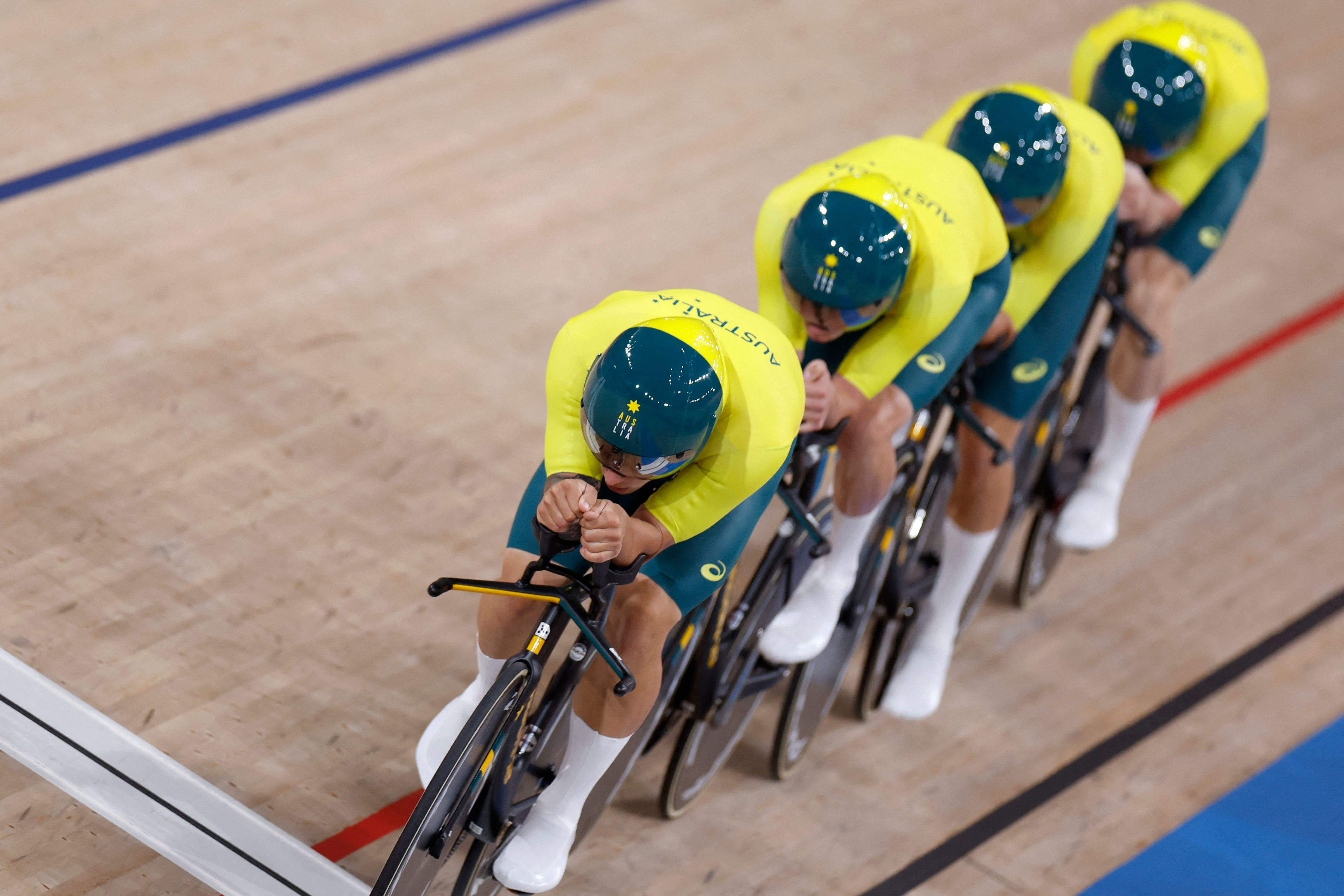

It was all change for 2021 as the Australian squad switched to Argon 18 carbon fibre track bikes, ending a long period of using BT frames.
The team had also switched handlebars and the Bastion 3D-printed titanium handlebar used by Alex Porter infamously snapped in qualifying sending the rider sprawling at 65km/h. Bastion later investigated the failure, as did an independent commission which found inadequate specification and fatigue testing to be the reason for the failure.
The team fought back and recorded a time of 3:44.902 in the following round before catching the New Zealand team in the Bronze medal ride-off after one of their team crashed.
Four years on from Rio though and pursuit positions were dramatically different with the praying mantis position in full effect and the chest space left by flatter arms completely closed up.
The team were on Zipp disc wheels, with the front hub looking to have a narrower spacing. An aero crankset and chainring were also featured, but we don't know if these were also manufactured by Bastion.
White aero overshoes were back, and they looked to have different panels incorporated into their design. Kit branding had switched to Asics, but we expect this was also a rebranded skinsuit.
Paris 2024
- 1st: 3:42.067
- *World Record in heats: 3:40.730


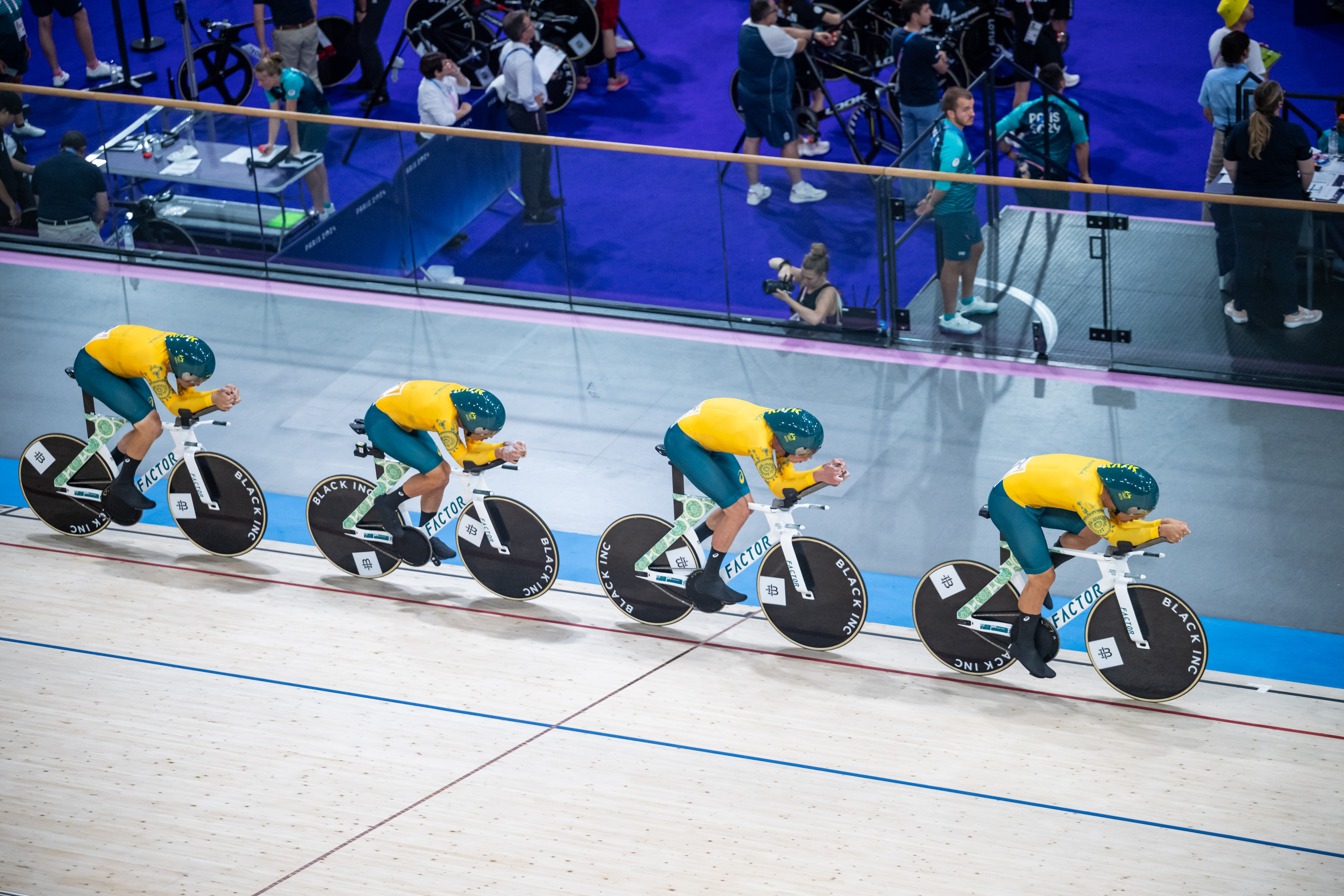
That's a whistle-stop tour of the last 20 years of Australian Team Pursuit, bringing us up to August 2024 at the Paris Olympics, where the team set a new World Record on their way to gold on their new Factor bikes, which replaced the Argon 18 models.
Sam Welsford, Oliver Bleddyn, Conor Leahy and Kelland O’Brien stopped the clock during the desperate final against Great Britain in 3:42.067.
The team used the Factor super wide, custom-painted track bike in Paris. Factor is another brand that has adopted the ultra-wide fork and seatstay frame design seen on the Look and Hope/Lotus bikes amongst others.
The bikes appear to feature great 3D printed time trial bars. They look a little like Wattshop Anemoi bars to us, which feature moulded handholds at the end of the extensions, and bring the rider's hands very close to their faces to minimise any potential gap around the chest.
The disc wheels are Black Inc. (a subsidiary brand of Factor) and the front looks to have a very narrow hub spacing. We can also spot Vittoria Pista Oro tubular tyres, priced at €223 per tyre. Wattshop Cratus crank arms also feature, and they spin on CeramicSpeed bottom bracket bearings.
Aero helmets were from Kask, and there appears to be an aero base layer worn under at least one of the riders Asics-branded skinsuits.
Get unlimited access to all of our coverage of the 2024 Olympic Games - including breaking news and analysis reported by our journalists on the ground from every event across road, mountain bike, track and BMX racing as it happens and more. Find out more.







